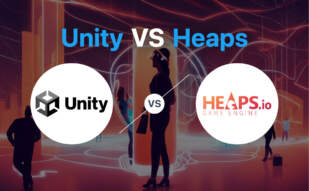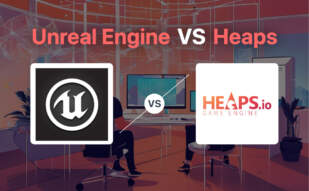Heaps is a mature cross-platform graphics engine designed for high-performance 2D and 3D game development, leveraging modern GPUs with deep storyline capabilities. It has a strong community following and is known for stability and performance optimization, powering games like Rushberry Mercs, Voidrun, and Nuclear Blaze.

For those exploring options beyond Heaps, alternatives include Unity, Unreal Engine, Godot, Stride, Babylon.js, Three.js, jMonkeyEngine, Phaser, O3DE, GameMaker, Construct 3, Raylib, Panda3D, Blender, and Solar2D.
Unity

Launched in 2005, Unity has established itself as a potent game development engine, widely acclaimed for the creation of compelling 3D and 2D games, extending its prowess across the vast domains of the gaming universe.
Unity Top Features
- Permits launch of cross-platform games encompassing the realms of Android and iOS platforms.
- Offers vast compatibility with different operating systems, revolutionizing the creation of augmented reality to 3D simulations.
- A rich asset store, laden with an array of pre-designed textures and features, facilitates brainstorming of game designs.
- Supports various coding languages, including BOO script, Javascript, and C#.
- Engages in constant innovation to enhance user-friendliness, compatibility and immersive visual experiences.
| Feature | Description |
|---|---|
| Active Developer Community | Serves as a conduit for problem-solving, feedback and system enhancement. |
| AR/VR game creation | Unity encourages the development of games with augmented reality and virtual reality features. |
| Indefatigable Learning | Unity provides a platform that promotes constant learning and application of new industry solutions. |
Unity Limitations
- Impending shift to a new per-install fee pricing model from January 1, 2024, brings concerns of financial instability among developers.
- Developers fear potential abuse of per-install fees, including repeated downloads by a single user.
- Lack of transparency in unannounced pricing shifts and policy changes has resulted in diminished trust among users.
Unity Pricing
The new per-install fee model will take effect from January 1, 2024, causing concern among developers. However, the company clarifies that charges will only apply to activity post this date and will not be levied until a game’s revenue surpasses $200,000 and records over 200,000 installations. An exemption exists for certain markets like India and China, where games attract a lower fee than those bought in the US, UK and other “standard” markets.
Unity Use Cases
Use case 1
Unity can be a boon for developers seeking to create cross-platform mobile games. Its compatibility, adaptability and comprehensive tool suite make it a powerful medium for crafting memorable gaming experiences.
Use case 2
Unity is an excellent choice for developers focusing on Augmented Reality and Virtual Reality games. Through its constant tech evolution, Unity fosters advanced and immersive visual experiences.
Use case 3
For indie developers, despite the pricing changes, Unity’s rich feature set and active community can significantly aid in creating a competitive and successful game.
Unreal Engine
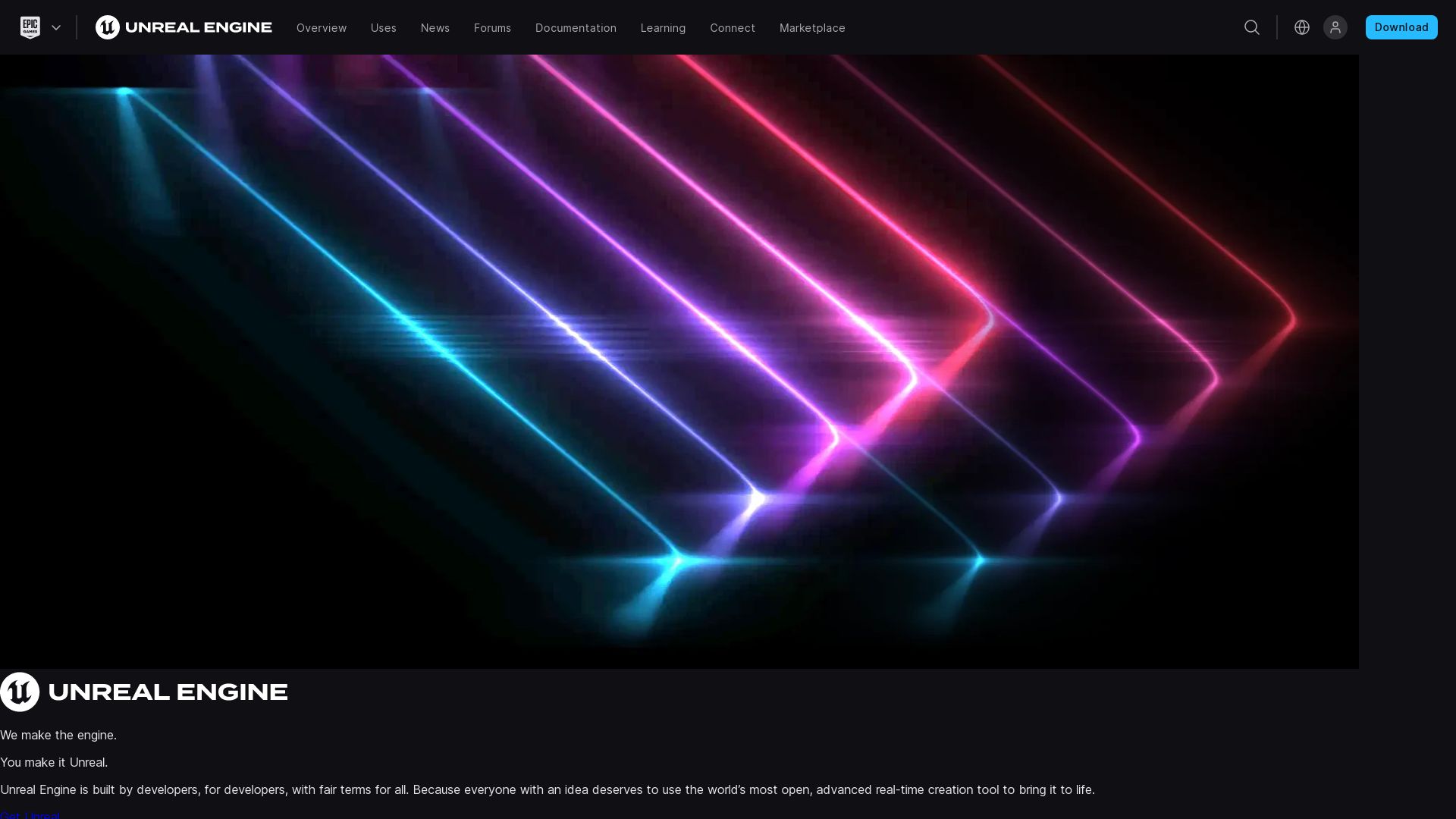
Developed by Epic Games, Unreal Engine (UE) is a formidable series of 3D computer graphics game engines. Introduced in 1998, Initially developed for PC first-person shooters, but now branches into various game genres as well as film and television.
Unreal Engine Top Features
- Written in C++, facilitating cross-platform usage.
- Enhanced by features acquired from companies such as Quixel.
- Includes an intuitive level editor, UnrealEd, that supports real-time constructive solid geometry operations.
- Unveiled the Unreal Development Kit (UDK) in 2009—a free version of UE3’s SDK that supports creating iOS games and apps.
- Empowers modders with openness as seen with Unreal Engine 3.
- Offers basic project templates for a variety of game experiences.
| Top Feature | Description |
|---|---|
| Unreal Engine 5 | The latest release, UE5, showcases ground-breaking technological advancements. |
| Unreal Engine Marketplace | Allows creators to sell their creations or purchase work from other developers with an impressive 88% revenue share. |
| Educational Access | Completely free for schools and universities, paving the way for next-gen developers. |
Unreal Engine Downsides
- High royalty model — Epic charges 5% on revenues over USD 1 million for commercial use.
Unreal Engine Pricing
Unreal Engine is essentially free for use, but imposes a royalty model where Epic charges 5% of revenues over USD 1 million for commercial use. The model is waived for games published on the Epic Games Store.
Unreal Engine Use Cases
Use case 1 – Game Development
Unreal Engine, with its robust suite of features, streamlines game development. Developers benefit from basic project templates, a friendly level editor, and the unique Unreal Development Kit.
Use case 2 – Modding
The openness of the Unreal Engine, particularly with Unreal Engine 3, fosters a mod-friendly environment. Engaging with the modding community, Unreal offers creative flexibility and innovation.
Use case 3 – Educational Purposes
Unreal Engine’s complete free access for schools and universities promotes learning. Aspiring developers can hop in and start experimenting, fostering an environment of early technical proficiency.
Construct 3

Developed by Scirra Ltd, Construct 3 is a dynamic HTML5-based 2D game engine that caters to both beginners and professional developers. With its logic-based ‘event sheets’, it enables swift creation of games, offering remarkable versatility. However, it primarily targets 2D games and may not be the perfect tool for 3D game development.
Construct 3 Top Features
- Event Sheets: Employs visual programming through ‘event sheets’ for straightforward game creation.
- Browser Flexibility: Fully accessible on any device and offers offline use support too.
- In-built pixel editor: For game graphics, and strong support of behaviors including solid, platformer, tile movement, etc.
- JavaScript Integration: Advanced users can use JavaScript as an optional scripting language.
- Compliance: It is compliant with data privacy regulations such as COPPA, CCPA, and GDPR.
| Feature | Description |
|---|---|
| Exporting Capabilities | Exports games into web-apps or uses an HTML wrapper, and supports exporting to various platforms like Windows, MacOS, Linux, Android, iOS, and Xbox. Web content support is also available. |
| Educational Use | Extensively used in schools for coding curriculum due to easy programming process & downloadable feature, with resources, including a starter curriculum, tutorials, manuals, and educator support. |
Construct 3 Limitations
- Constrained in creating large-sized games.
- Primarily focused on 2D games, hence not ideal for 3D game development.
- Non-native exporters, exporting for HTML5 and Construct 3 is dependent on the device’s support for web content.
- Lacks support for native and offline application behavior leading to limited creations on platforms like Apple TV.
Construct 3 Pricing
Construct 3 offers a free version as well as a paid subscription with more features. The pricing for the personal plan starts from $99 per annum.
Construct 3 Use Cases
Use case 1
The versatility and simplicity of Construct 3 makes it a popular choice among indie developers
Use case 2
Construct 3 is academically embraced by educators and used for teaching code in over 400 schools across 48 states in the United States.
Use case 3
Thanks to its browser flexibility and offline support, Construct 3 is suitable for users in regions with poor Internet connectivity.
Raylib
Born in 2013 and conceived by Ramon Santamaria, Raylib is a feature-rich, robust game development engine. It finds its roots in C99 and is inspired by the notable Borland BGI graphics library and the XNA framework.
Raylib Top Features
- Boundless reach: Has bindings for over 50 programming languages, allowing you to build in the language of your choice.
- Dependable: Comes with all required libraries, so no external dependencies are necessary.
- Amplified Performance: With built-in OpenGL hardware acceleration and a unique OpenGL abstraction layer (rlgl).
- Multi-format Support: Supports multiple texture formats, including compressed formats.
- Superior 3D Support: Full 3D support including Models and Post processing shaders for realistic visuals.
- Audio Capabilities: Proffers audio loading, playing and streaming support across various formats.
| Feature | Benefits |
|---|---|
| Improved shaders loading | Makes attaching shaders to 3D models or fullscreen postprocessing effects seamless. |
| Raycast system | Offers 3D picking capabilities with unique ray collision-detection functions. |
| Persistent data storage | Allows convenient and reliable storage access through two simple functions. |
Raylib Limitations
While Raylib is teeming with features, it is worth noting that no platform is without its downsides. Some potential drawbacks could include a steep learning curve for those new to C99 and the lack of certain advanced features found in larger, commercial game development engines.
Raylib Pricing
Incredible news for developers – Raylib is an open-source project and therefore, free to use. This allows you to experiment, build and reshape your gaming vision without financial concerns.
Raylib Use Cases
Use case 1: Education
A powerful tool in the teaching realm, it’s widely used for teaching videogame programming globally, thanks to its flexibility across languages and platforms.
Use case 2: Prototype Development
Sprints become smoother when using Raylib as the game engine, since it is highly suited for prototyping and tooling.
Use case 3: Tools Development
Post its pivot to tools development under Raylib, this engine has won awards from Google and Epic Games, providing the validation for it’s prowess in this space.
Panda3D

Born out of Disney’s innovative labs, Panda3D is an open-source engine that provides an extensive suite of tools for 3D game development. It’s powerful and flexible, making use of Python and C++ for development with a feature set that spans graphics, audio, I/O, and collision detection.
Panda3D Top Features
- Open-source engine written in C++, supporting Python for scripting.
- A strong choice for 3D rendering and game development.
- Advanced functionality like custom shaders, modern per-pixel lighting techniques, 3D audio, physics system, and network options.
- Robust and automatic memory management, thanks to Python’s garbage collector.
- Supports cross-compilation for Android and comprehensive test runs using PyTest.
| Use Case | Sample Applications |
| Game Development | Globally successful games like Toontown Online and Pirates of the Caribbean Online |
| Virtual Reality | Used for VR research projects with universities and for creating 3D theme park attractions |
| Teaching and Learning | Used in university courses to teach game development and 3D modeling |
Panda3D Limitations
- Not a choice for beginners. It requires a fundamental understanding of Python and APIs.
- Without standardized UI elements, developers may face difficulties in interface design.
Panda3D Pricing
This robust engine is open source and free, enabling developers regardless of budget to dive into the complex world of 3D game development.
Panda3D Use Cases
Use Case 1: Commercial Game Development
With its comprehensive suite of features, Panda3D has proved to be a dependable choice for developing large commercial games, as evidenced by its use in games like ‘Ghost Pirates of Vooju Island’ and ‘A Vampyre Story’.
Use Case 2: Teaching and Learning
Its opensource nature and support for Python make Panda3D an educational tool, helping students understand game development intricacies.
Use Case 3: Virtual Reality Research
Originally created for Disney VR studio projects, Panda3D showcases substantial potential for VR research projects, giving a solid foundation for university research endeavors.
Blender

Welcome to the world of Blender – your one-stop solution for 3D computer graphics. Hold on to your hats because this software toolset is free, open-source, and has enough firepower to be used in animated films, visual effects, art, 3D-printed models, motion graphics, interactive 3D applications, and virtual reality. Once an SGI freeware released by the Dutch animation studio NeoGeo, now, a weapon wielded by artists worldwide.
Blender Top Features
- 3D Modeling: Shape virtual clay into the design of your choice.
- UV Mapping and Texturing: Flaunt your creativity by adding uniqueness to your creations.
- Digital Drawing and Raster Graphics Editing: Sketch, color, and illustrate like a pro.
- Animations: Bring your art pieces to life with the magic of motion.
- Match Moving: Imbue your graphics with the charm of believable reality.
| Additional Features | Unique Attributes |
|---|---|
| Rigging and Skinning | Flexible bone structures for animated characters |
| Fluid and Smoke Simulation | Realistic portrayal of natural elements |
| Soft Body Simulation and Sculpting | Ideal for creating lifelike characters |
Blender Limitations
- Blender Game Engine depreciated in 2.8 release.
- Blender Internal was removed in 2.80 release, favoring the Eevee renderer.
Blender Pricing
Free as a bird. Open your arms to the open-source world. No hidden charges!
Blender Use Cases
Use case 1: Animated Films
Use Blender to craft animated films with 3D models that are a joy to watch.
Use case 2: Visual Effects
Need breathtaking visual effects? Lean on Blender’s spectral array of CGI tools!
Use case 3: Virtual Reality
Dive into alternate realities crafted with Blender’s 3D modeling and animation features.
Solar2D

A marvel of the digital age, Solar2D, formerly known as Corona SDK, is an ingenious platform for cross-platform mobile app development. Birthed in 2009, and fortified by over a decade of diligent development and refinement, Solar2D is a playground where creativity meets functionality, empowering developers to utterly redefine their paradigms of app design and creation.
Solar2D’s Best Features
- Single-Code Base: Design and implement for mobile, desktop, TV devices using just one concise code base.
- Instant Update Simulator: Real-time testing of code and asset alterations, revolutionizing the traditional delay-laden debugging processes.
- Lua-Based Scripting: Work with a leading scripting language in the gaming world, used in popular franchises like Warcraft, Angry Birds, and Civilization.
- Free Accessibility: No hidden fees or royalties, Solar2D practices the principle: “Privacy First”, with no instance of tracking or data gathering.
| Feature | Benefit |
|---|---|
| Live Builds | Witness your codebase come alive with instant updates over local network |
| Open Source (MIT License) | The freedom to modify and distribute code as per your needs |
| Powerful APIs | Faster frame rate bringing longevity and fluid experience |
Solar2D Downsides
The one possible shortcoming of Solar2D is that it doesn’t support 3D game development. While it’s a powerhouse for 2D mobile application development, for 3D games developers might have to find an alternative. However, the company compensates for this with its in-depth dedication towards 2D game design.
Solar2D Pricing
Excelling in its generosity, Solar2D is free, making it an open-source paradise of development tools. Right from the start, it has believed in a democratized, accessible future for game developers all across the spectrum.
Solar2D Use Cases
Use case 1
Harnessing the power of Solar2D, an indie game developer can bring their unique vision of an immersive mobile game to life. From intricate design options to real-time simulation of game elements, this platform is a boon to the game-creator’s endeavor.
Use case 2
For an education-based software solution provider, Solar2D can serve as a powerful tool for developing interactive learning applications. The cross-platform functionality makes it especially ideal for reaching a greater audience base.
Use case 3
In the realm of digital marketing, Solar2D could be utilized by businesses aiming to create media-rich interactive applications, boost engagement, and increase revenues thanks to integrated in-app advertising and analytics.
Godot
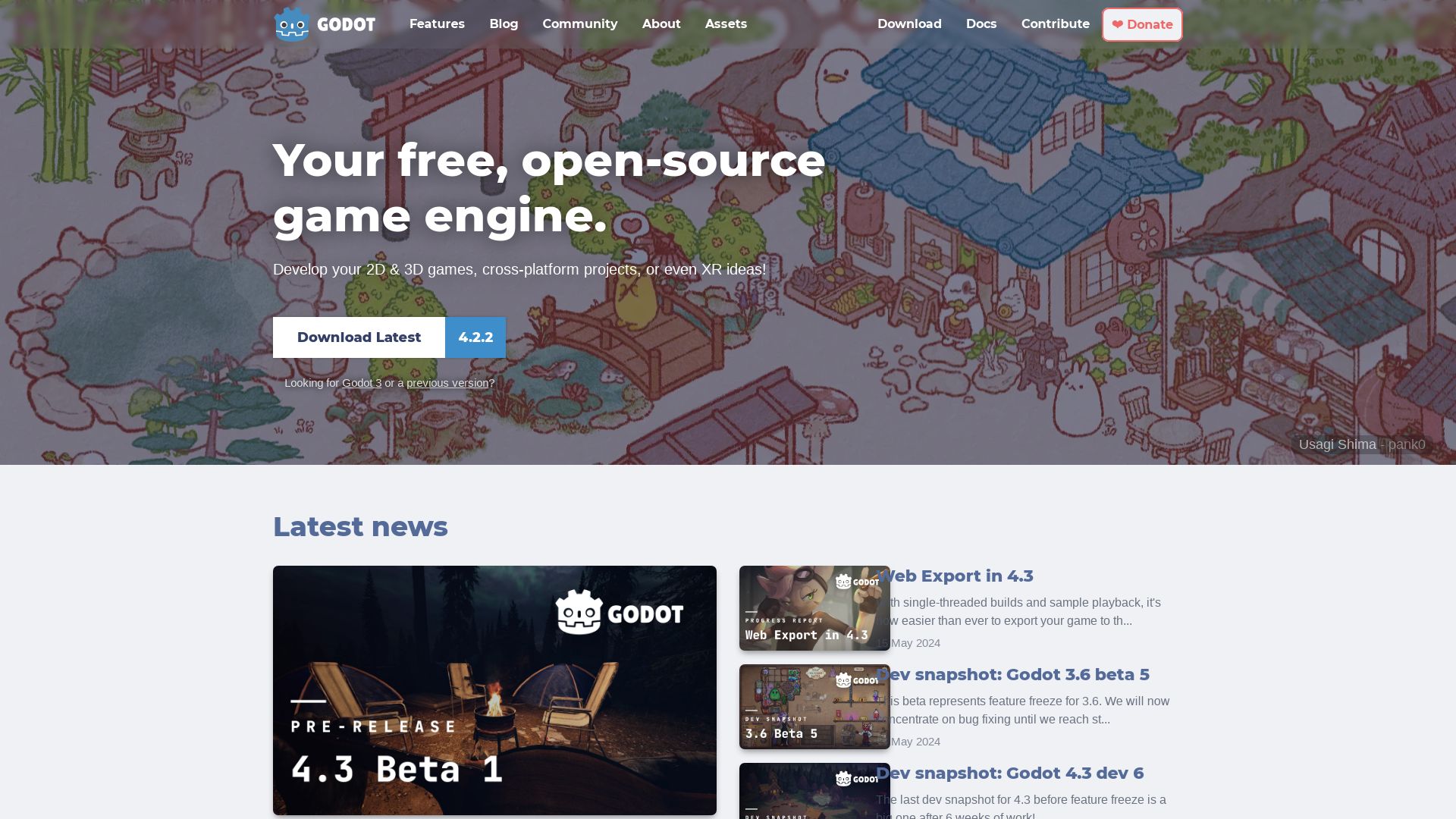
An open-source powerhouse in the arena of game development engines, Godot garners popularity for its intuitive scene-driven design and flexibility.
Godot Top Features
- Open-Source: Modifiable codebase makes Godot a favorite among developers looking for customization.
- Scene-Driven Design: Creation of games using simple building blocks through nodes, both complex and reusable, is at the heart of Godot.
- Scripting Support: Built-in GDScript language, C# for .NET platform, Official C++ support in 4.0 with GDExtension API, along with community support for languages like Rust, Nim, Python.
- Direct Import: Allows direct import of Blender files adding to the ease of game development.
- 2D Workflow: Specialized for games and apps.
| Platform Support | Language Support |
|---|---|
| Desktop platforms, Android phones, tablets, and multiple Web platforms. | GDScript, C++, and C#, with community support for Rust, Nim, Haskell, Clojure, Swift & D. |
| Includes an audio bus/layout system with real-time effects implemented. | Regular updates and improvements to keep up with the evolving gaming industry. |
Godot Downsides
- Not suitable for complex 3D game development.
- .NET platform support is only available for desktop platforms in Godot 4.
Godot Pricing
Under the generous MIT license, Godot is free without any hidden fees, contracts, or licensing costs.
Godot Use Cases
Use case 1 – Indie Game Developers
With its open-source nature, Godot provides a cost-effective and customizable option for independent game developers pioneering small to mid-sized projects.
Use case 2 – Education Sector
For educational purposes, Godot’s intuitive block-building system makes it an excellent tool for teaching the basics of game development.
Use case 3 – 2D Web Games
In domain of 2D web games, Godot’s strong 2D workflow and wide-ranging web platform support make it an ideal choice.
Stride
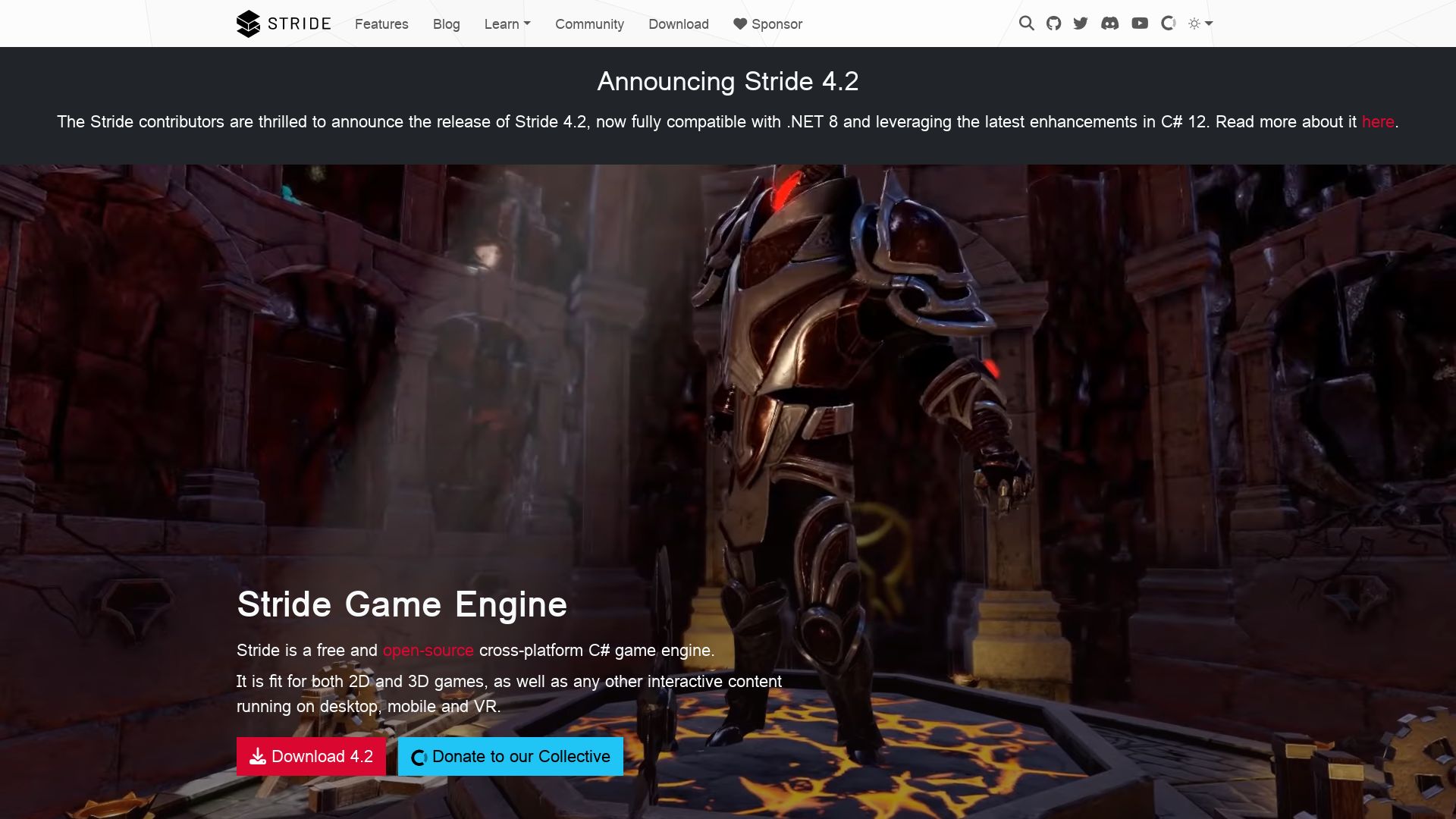
A dynamic cross-platform, free and open-source game development engine, Stride, initially known as Xenko, offers a versatile platform for creating both 2D and 3D video games. Initially supported by Silicon Studio, Stride is today a community-driven engine with a depth of features.
Stride Top Features
- C# suite tools facilitate seamless game development.
- Stride offers a customizable shader system that allows creators to tailor their game’s visuals.
- An integrated environment, the Game Studio, simplifies tasks like asset import, scene creation, arrangement using the Entity component system, script assignment, game building, and running.
- Stride supports cross-platform runtime on iOS, Android, Windows UWP, Linux, and PlayStation 4.
- The inclusion of a 3D rendering engine for the visual programming environment, vvvv gamma, extends Stride’s application beyond just game development.
| Tools | Description |
|---|---|
| Physically-Based Rendering (PBR) layered material editor | Facilitates the creation of hyper-realistic visuals and scenes. |
| Photorealistic postprocess effects | Enhances visual detail post production. |
| Particle editor, Scene streaming system, Full tool-chain, Sprite editor, Scripting editor | Comprehensive suite for editing, streaming, and managing game elements, scripts, and sprites. |
Stride Limitations
- It requires a steep learning curve particularly for beginners.
- Community support can be slow to respond due to the open-source nature.
Stride Pricing
Stride is a free, open-source software. There is no cost associated with using it.
Stride Use Cases
Use case 1 – Game Development
Stride is a powerful tool for indie game developers providing a broad array of tools for 2D and 3D game creation for different platforms including PC, mobile devices, and virtual reality.
Use case 2 – Cross-platform Development
With its support for iOS, Android, Windows UWP, Linux, and PlayStation 4, Stride is an excellent choice for developers seeking to deploy games on multiple platforms.
Use case 3 – Visual Programming
Stride’s inclusion of a 3D rendering engine for the visual programming environment, vvvv gamma, makes it perfect for creators seeking to produce dynamic, visually stunning experiences beyond traditional gaming.
Babylon.js
A product of Microsoft’s creative laboratory, Babylon.js is a pioneering real-time 3D engine that harnesses the power of HTML5 to bring immersive 3D graphic experiences directly to your web browser. With a supportive community of over 190 contributors as of 2018 and free GitHub source code under the Apache License 2.0, Babylon.js democratizes 3D development.
Babylon.js Top Features
- A versatile 3D engine born from TypeScript and JavaScript, enabling remarkable compatibility and usage in browsers supporting HTML5 and WebGL.
- Users have access to the API for their projects, providing an extra degree of customization and control.
- Realistic, flawless visuals achieved through physically based rendering and post-processing.
- Engaging animations made possible through key frame animation objects and characters brought to life with skeletons equipped with blend weights.
| Modelling Process | Polygon modelling using triangular faces and limited use of constructive solid geometry for complex shell models. |
| Rendering | Models are beautifully rendered on HTML5 canvas, with pixel positions and colors set meticulously by shader program. |
| Physics Engines | Plug-in physics engines such as Cannon.js and Oimo simulate and replicate real-world physical reactions and collisions for an authentic feel. |
Babylon.js Limitations
- Limited use of constructive solid geometry with only union, subtraction and intersection of shell models in play.
- The necessity of using HTML5 and WebGL supporting browsers which may limit accessibility for some users.
Babylon.js Pricing
Good news! Babylon.js is an open-source 3D engine, making it freely available to users with its source code hosted on GitHub and distributed under the Apache License 2.0. This makes it not just cost-effective, but a perfect example of how innovation and community can thrive together.
Babylon.js Use Cases
Use case 1 – Education in Medicine
The realistic 3D modeling capabilities of Babylon.js make it a powerful tool for educational purposes, especially in complex fields like medicine, where it can be used to create highly detailed and accurate anatomical models.
Use case 2 – Military Training
Military training can greatly benefit from the accurate physics simulations offered by Babylon.js. It provides a risk-free environment to simulate real-world combat scenarios and test strategies.
Use case 3 – Product Design
In the realm of product design, Babylon.js flexes its prowess, allowing designers to model and visualize their products in 3D before production, thus streamlining the design process and reducing resource consumption.
Three.js
A dynamic JavaScript library, Three.js, offers an API for creating and displaying animated 3D computer graphics right in your web browser. There’s no need for any browser plugins as this magic happens through WebGL and GPU-accelerated 3D animations with JavaScript. The initial release was by the visionary, Ricardo Cabello in April 2010, and it has since been developed by the dedicated Three.js Authors.
Three.js Top Features
- GPU-accelerated 3D Animations: Leverage the power of GPU-applied 3D animations using JavaScript.
- Cross-browser support: Runs seamlessly in any browser that supports WebGL 1.0.
- WebGL 2.0 Integration: From version 118, Three.js utilizes WebGL 2.0 as default, enriching the graphics experience.
- WebXR Support: Three.js facilitates both Virtual and Augmented reality experiences via WebXR.
| Open Source | Support and Collaboration |
|---|---|
| The MIT License allows you free reign over the code, thus promoting creativity and innovation. | The Three.js community on Github boasts over 1700 contributors, providing endless support and collaboration opportunities. |
Three.js Limitations
- Limited to only browsers that support WebGL 1.0 or above.
- Understanding WebGL and JavaScript might have a learning curve for beginners in 3D modeling.
Three.js Pricing
Guess what? It’s free. Being an open-source library, Three.js comes with no pricing tags. Dip your feet into the realm of 3D animations without any cost constraints.
Three.js Use Cases
3D Modeling
Three.js stands as an ideal tool for 3D modeling enthusiasts. Incorporate interactive 3D animations into your websites without breaking a sweat.
AR/VR Solutions
With its built-in WebXR support, Three.js is leveraged by developers to create immersive VR and AR experiences, aiming at a more interactive user engagement.
Game Development
Three.js, with its rich repertoire of features like multiple effects, scenes, and animations, brings a solid base to the game development arena.
jMonkeyEngine
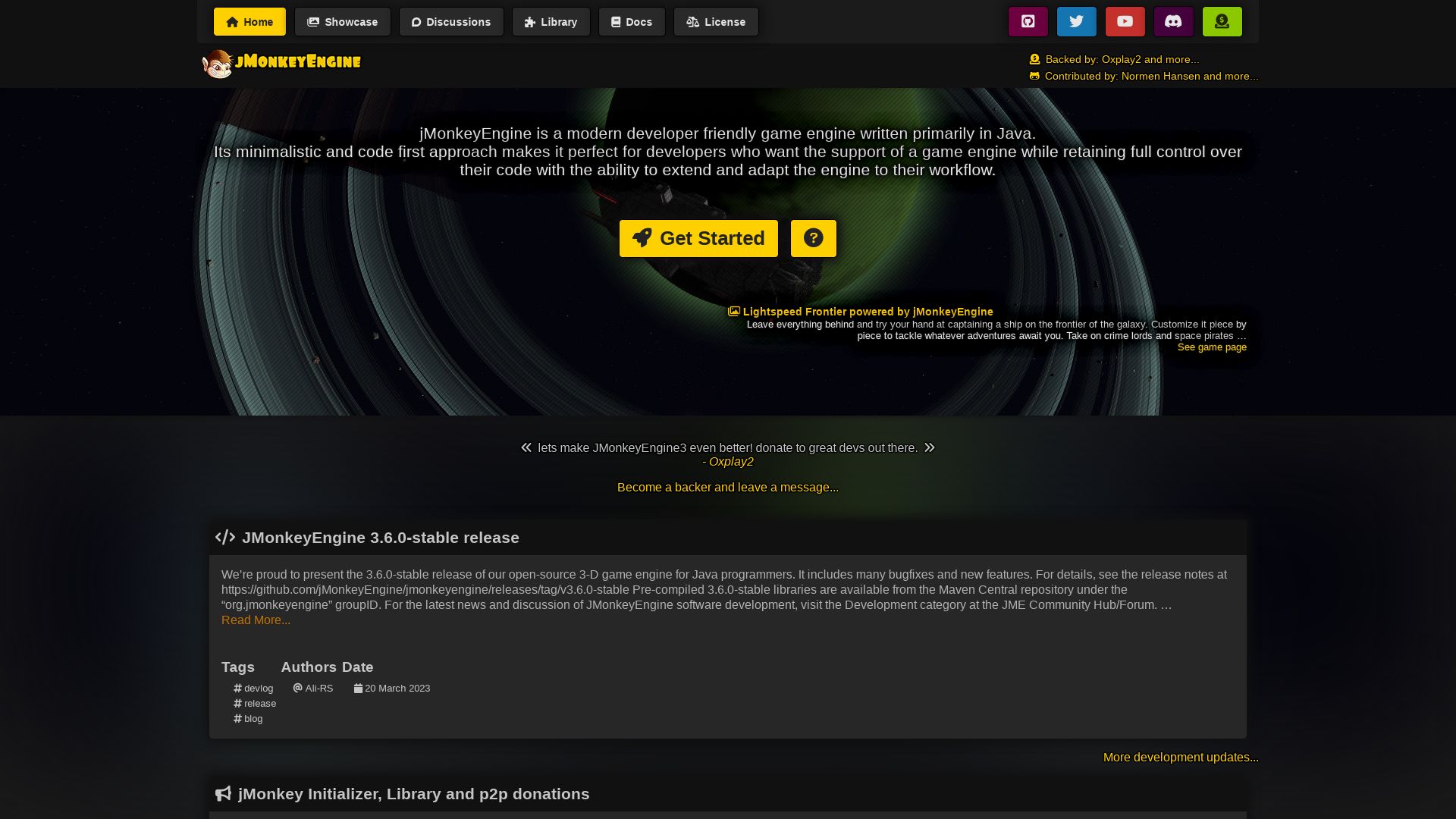
Established as a dominant presence in game-education programs for both young and adult learners, jMonkeyEngine is a Java-based game engine that revolutionizes the game development landscape. Its core ethos centers around a minimalist, code-first approach, making it a practical choice for developers looking for lower-level, yet high-quality games with an easier learning curve than alternatives like Unity.
jMonkeyEngine Top Features
- Capable of turning out visually immersive games through its stunning post-process water and light scattering and bullet physics.
- Offers 3D audio support with OpenAL and jmePhonon for in-depth sound experiences.
- Provides a plethora of choices for GUI, including Lemur, Nifty GUI, and IGUI.
- Allows for networking with options like Spidermonkey, SimEthereal, and Monkey Netty.
- Empowers advanced terrain libraries and particle capabilities.
| Extra Feature | Description |
|---|---|
| Open-Source | Open-source Game Engine targeted at Java programmers |
| Active Community | Backed by a vibrant community of developers for continuous support |
| Export Options | Compatibility across PC, Linux, iOS, Android, and Mac for versatile game publishing |
jMonkeyEngine Downsides
- While it trumps Unity in terms of ease of use, it has its limitations when compared to higher-level game development tools.
- Though it’s an excellent resource for educational game development, it may not be the first choice for hardcore gamers.
jMonkeyEngine Pricing
Good news for developers on a budget – jMonkeyEngine is free and open-source under the permissive BSD 3-Clause license.
jMonkeyEngine Use Cases
Use case 1 – As a Teaching Tool
JMonkeyEngine is an ideal resource for teaching students about game development, affordable and easy-to-understand, it is preferred by educators for introducing coding concepts.
Use case 2 – For Developers
Developers seeking to create impactful games without entering into the complexities of Unity find that jMonkeyEngine is a perfect alternative that allows them to code their way to great games.
Use case 3 – For Indie Developers
Economical and accessible, jMonkeyEngine is a platform for indie developers looking to publish their games on multiple platforms like Steam and indiedb.com.
Phaser
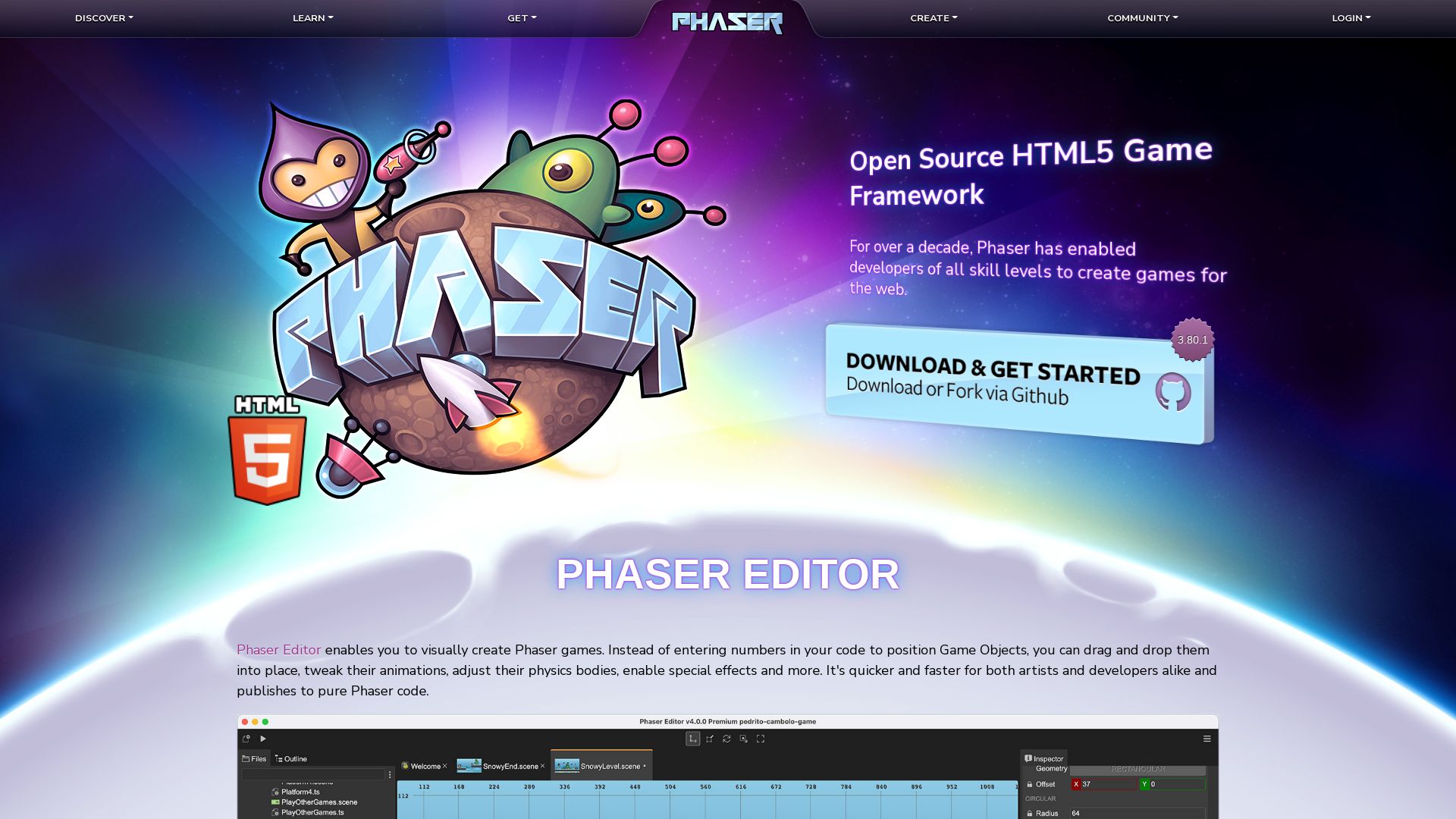
Phaser, a 2D game framework launched in 2013 by Richard Davey, enables HTML5 game development for both desktop and mobile. Built on JavaScript and TypeScript, it features flexible usage via es6+webpack, CDN, and its compatibility with any browser supporting canvas element.
Phaser Top Features
- Multiple rendering options: boasts Canvas, WebGL renderer for fast rendering with auto-switching based on browser support.
- Flexible deployment: Phaser games can be deployed to iOS, Android, and native desktop apps using tools like Apache Cordova, PhoneGap.
- Rich in physics systems: supports Arcade Physics, Ninja Physics, and P2.JS.
- 1800+ examples and an active community support for easy game development.
- Phaser is frequently updated, with Phaser 4 currently in development.
| Phaser Version | Salient Features |
| Phaser 1 | Incorporates Pixi.js library. |
| Phaser CE | Regarded as the current stable platform. |
| Phaser 3 | Features custom WebGL renderer & a modular structure. |
Phaser Limitations
- Lacks support for 3D game development.
- Being a JavaScript-based framework, performance can be impacted on mobile devices.
- Extensive selection of features can lead to initial learning curve for beginners.
Phaser Pricing
Phaser is an open-source engine, thus offering a cost-effective solution for game developers.
Phaser Use Cases
Use Case 1: Browser-based Games
For developers looking to create browser-based games, Phaser provides the flexibility to be compatible with any browser supporting the canvas element.
Use Case 2: Learning Resource
With its robust learning resources and an active community, Phaser is an excellent starting point for individuals keen on learning game development.
Use Case 3: Mobile Game Development
Phaser accommodates Android game development, promoting a wider audience reach for developers.
O3DE
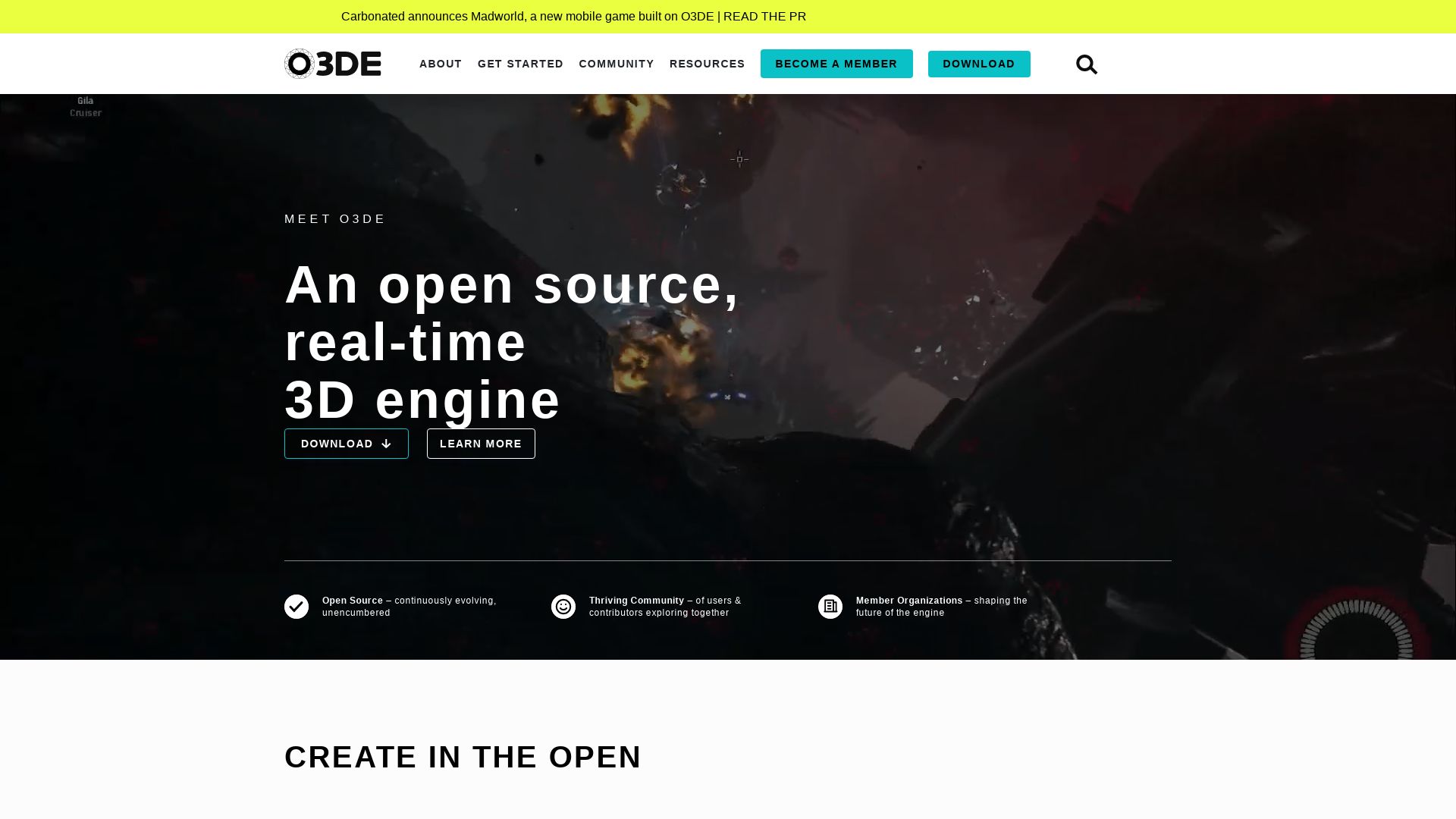
The O3DE or Open 3D Engine, known for its open-source, real-time 3D engine capabilities, allows for the construction of high-performance, interactive experiences in game development and simulation fields. Originating from the Amazon Lumberyard, O3DE is supported by an impressive range of industry titans, including AWS, Tencent, and Microsoft.
O3DE Top Features
- C++, Lua, and Python support for a broad coding base.
- Precompiled gems. These can be added or removed without having to recompile the entire O3DE, thus enhancing flexibility.
- Modular engine composed of Gems (libraries with standard interfaces) for targeted functionality.
- Tools like a physically based renderer, runtime logic, networking capabilities, and data-driven asset workflows.
- Python scripting support and high-performance math libraries for advanced game mechanics.
| Build Requirements | Visual Studio 2019 16.9.2 minimum; CMake 3.22.0 minimum |
| Supported Platforms | Windows, Linux, iOS |
| Extension Languages | C++, GDScript, C#, Unity’s C# |
O3DE Limitations
- Requires higher system requirements: Windows 10 1809 or higher, or Ubuntu 20.04 or higher.
- Lumberyard-based games like New World have received mixed reviews, indicating possible challenges in creating successful games.
- O3DE faces competition from established engines: Unreal Engine, Godot, Unity.
O3DE Pricing
Operational under the Apache License, Version 2.0, MIT license, O3DE is a free and open-source solution. It delivers robust functionality without imposing royalty fees.
O3DE Use Cases
Use case 1: Advanced Game Development
O3DE’s broad coding base, modular engine, and physically based renderer make it a strong choice for professionals in the game development industry. Its data-driven asset workflows streamline the creation process.
Use case 2: Real-time Simulations
With its strong Python scripting support, high-performance interactive experiences, this game engine serves well for real-time simulations in various fields.
Use case 3: App Development
Thanks to its compatibility with platforms like iOS and Android, and liberating licensing system, O3DE is also a commendable choice for app developers.
GameMaker
An engine celebrated for its 2D gaming capabilities, GameMaker simplifies game design. Aided by advancement over 17 years since its birth as Animo in 1999, this toolset is recognized for the successful games it has produced, including classics like Undertale and Spelunky, and its scalability that caters to beginners and full-time developers alike.
GameMaker Top Features
- Remarkable simplicity and scalability, ideal for beginners and skilled developers.
- Offers a Language Server for Syntax Highlighting and Intellisense support which aids in supporting multiple languages like Shader Languages (GLSL, HLSL), JSON, and XML.
- An imminent new code editor with full-screen window access to objects, events, and functions.
- Committed to regular engine updates based on customer feedback and routine maintenance.
- Exciting forthcoming updates like AI support and enhanced modding capabilities.
| Feature | Benefit |
|---|---|
| Mod.io extension | Eases the addition of user-generated content to games |
| AI Integration | Simplifies the game-making process through partnership with OpenAI |
GameMaker Limitations
While GameMaker is praised for its simplicity and scalability, it primarily excels in 2D game development, which may be a limitation for developers seeking complex 3D game creation tools. Detailed info on its limitations is not available.
GameMaker Pricing
GameMaker proposes various pricing tiers: Free for beginners, Creator for development on desktop stores, Indie with multiple export options, and Enterprise for studio releases on major consoles. This tiered approach caters to different needs and budgets, ensuring everyone has access to game development.
GameMaker Use Cases
Use case 1: Indie Developers
With a rich library of features and support for multiple languages, GameMaker is favored by indie developers. This toolset has launched successful titles like Undertale, suggesting its robust capabilities for launching indie games.
Use case 2: Novice Developers
Known for its simplicity, GameMaker provides an ideal starting point for novice developers, offering a seamless entry to the world of game design.
Use case 3: Studios Planning Major Console Releases
With its Enterprise package, GameMaker is apt for studios planning release on major consoles. This indicates its effectiveness as a toolkit for large-scale, professional game development.
Logan Bellbrook
Content writer @ Aircada with a knack for nature & AR/VR/XR. Blogging the intersection of tech & terrain.



